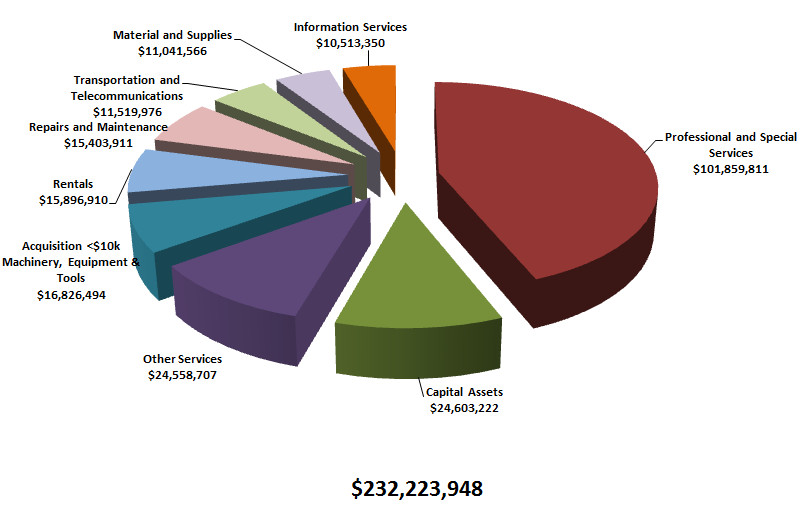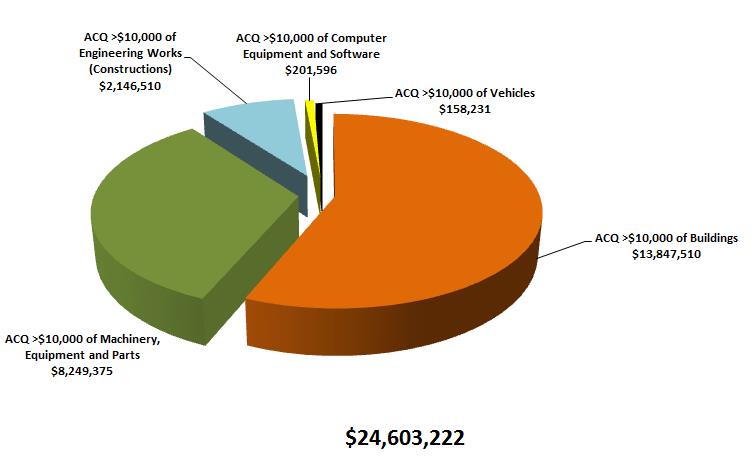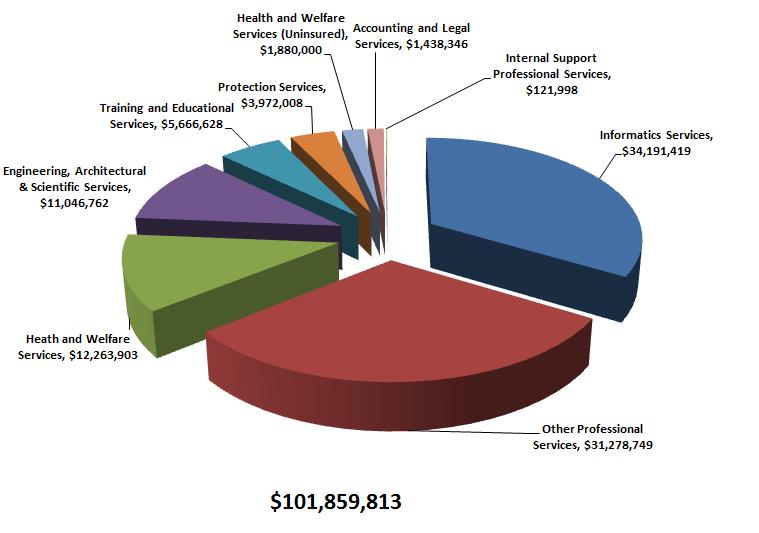Health Canada procurement plan (assets and acquired services) 2018 to 2019
Purpose of the procurement plan
Health Canada’s Procurement Plan complements the department’s activities in support of proactive disclosure. The Plan is designed to provide a high level summary of the department’s planned procurement activities for the fiscal year 2018 to 2019. The plan neither represents a solicitation or a request for proposal, nor is it a commitment by the Government to purchase any of the described property or services.
The objective of government procurement
Government contracting must be conducted in a manner that will:
- Stand the test of public scrutiny in matters of prudence and honesty, facilitate access, encourage competition and reflect fairness in the spending of public funds
- Ensure the pre-eminence of operational requirements
- Support long-term industrial and regional development and other appropriate national objectives, including aboriginal economic development
- Comply with the government's obligations under the North American Free Trade Agreement (NAFTA), the World Trade Organization Agreement on Government Procurement (WTO-AGP), the Canadian Free Trade Agreement (CFTA)
Key procurement drivers
Health Canada is currently transitioning from its Program Alignment Architecture and a supporting performance measurement framework to a Departmental Results Framework with two core responsibilities:
- Health care systems
Health Canada provides national leadership to foster sustainable health care systems that ensure access for Canadians to appropriate and effective health care.
Under the Health Care Systems core responsibility, Health Canada provides national leadership to foster sustainable health care systems. This is mainly achieved through partnerships with provincial and territorial governments and support through targeted funding agreements to organizations and key pan-Canadian health partners that are contributing to health system improvements. - Health protection and promotion
Health Canada works with domestic and international partners to assess, manage and communicate the health and safety risks and benefits associated with health and consumer products, food, chemicals, pesticides, environmental factors, tobacco and controlled substances.
Within the health protection and promotion core responsibility, Health Canada works with domestic and international partners to help protect Canadians by identifying health and safety risks. These risks are managed through rigorous regulatory frameworks and by communicating risks and benefits to Canadians so that they can make informed decisions. This work relates to the health and safety of health and consumer products, food, chemicals, pesticides, environmental factors such as air and water quality, tobacco and controlled substances, including cannabis. The distinction between the roles of Health Canada and the Public Health Agency of Canada is outlined in the descriptions of the Core Responsibilities, and expressed in unique departmental results statements and indicators.
Health Canada will deliver on its results for Canadians, in part, through procurement activities that support the priority areas identified in the Health Canada 2018–19 Departmental Plan.
The responsibilities for the First Nations and Inuit Health Branch have been formally transferred from Health Canada to Indigenous Services Canada. Historical and trend data in this report has been revised accordingly to reflect the transfer.
A key consideration for the department is the need for flexibility and agility in its procurement planning and execution within the confines of Government of Canada legislation and policies related to procurement, as well as, national and international trade agreements.
Governance and procurement standards
Governance
Health Canada has a robust governance structure in place for monitoring and controlling its procurement activities. The structure includes automatic electronic standardized business process mapping through the departmental financial system (SAP), which includes a procurement specialist review and functional oversight through a two-tier Contract Review Committee for ensuring compliance to policies and regulations.
Procurement management activities (planning, tendering, acquisition and closure) are subject to reviews and audits by various organizations including the Office of the Auditor General, Health Canada’s Audit and Accountability Bureau, and the Office of the Procurement Ombudsman. Findings that strengthen the department’s procurement processes are addressed through an audit Management Report Action Plan and its implementation is subject to oversight through the department’s Executive Committee on Planning and Accountability and Health Canada’s Departmental Audit Committee.
Procurement standards
Health Canada is committed to ensuring that competitive procurement is standard practice whenever possible. To support this, the department adheres to the following practices:
- Seeks tender proposals from potential suppliers using Buyandsell.gc.ca for all procurements subject to national and international trade agreements, including:
- CFTA
- WTO-AGP
- NAFTA (brought into force January 1, 1994)
- Utilizes competitively issued standing offer agreements, supply arrangements, and other tools put in place both by the department (that is, translation Services, French language training, nursing services, printing, employee assistance program, etc.) and by the Government of Canada’s primary procurement body, Public Services and Procurement Canada (that is, furniture, office machines, text processing systems and visible record equipment, office supplies and devises, task based informatics professional services, task and solutions professional services, professional services online, temporary help services, etc.)
- Ensures that all requirements, whenever benefits from competition are attainable, seek tender proposals from three or more potential suppliers for requirements not subject to the trade agreements or where there is an obligation to publish a requirement on Buyandsell.gc.ca.
Tendering process
Buy and sell
Buyandsell.gc.ca is an on-line system that advertises government contracting opportunities to potential bidders.
Health Canada publishes Advanced Contract Award Notices (ACAN) through Buyandsell.gc.ca to notify suppliers of the intent to award a contract directly to a supplier and to consider statements of qualifications from any suppliers capable of fulfilling the requirement.
Planned procurement volumes
The department's procurement planning process is included in Health Canada’s Departmental Integrated Operational Planning (DIOP) process and performance reporting regime, which allows the department to identify economies of scale through consolidation of acquisitions, resulting in increased flexibility and avoiding delays through greater use of Standing Offer Agreements and identifying opportunities for enhanced service delivery.
As part of the annual DIOP process, all branches within the department are requested to identify their planned expenditure activity for assets and acquired services. For the 2018 to 2019 fiscal year this exercise resulted in the identification of planned expenditures with an estimated value of $232.2 million, as follows:

Source: Integrated Planning and Performance Reporting System Templates June 2018
Figure 1 - Text Description
A pie chart illustrating the dollar value of the department's planned procurement of capital assets, acquired services, materials and supplies by G/L group
- Professional and special services: $101,859,811
- Capital assets: $24,603,222
- Other services: $24,558,707
- Acquisitions greater than $10,000 in machinery, equipment and tools: $16,826,494
- Rentals: $15,896,910
- Repairs and maintenance: $15,403,911
- Transportation & telecommunications: $11,519,976
- Materials and supplies: $11,041,566
- Information services: $10,513,350
Total: $232,223,948

Source: Integrated Planning and Performance Reporting System Templates June 2018
Figure 2 - Text Description
A pie chart illustrating the dollar value of the department's planned procurement of capital assets by G/L group
- Acquisitions greater than $10,000 in machinery, equipment and parts: $8,249,375
- Acquisitions greater than $10,000 in engineering works: $2,146,510
- Acquisitions greater than $10,000 in vehicles: $158,231
- Acquisitions greater than $10,000 in buildings: $13,847,510
- Acquisitions greater than $10,000 in computer equipment and software: $201,596
Total: $24,603,222
Professional and special services account for approximately 44% of planned procurement activities broken down as follows:

Source: Integrated Planning and Performance Reporting System Templates June 2018
Figure 3 - Text Description
A pie chart illustrating the dollar value of the department's planned procurement of professional and special services by G/L grouping
- Informatics services: $34,191,419
- Other professional services: $31,278,749
- Health and welfare services: $12,263,903
- Engineering, architectural and scientific services: $11,046,762
- Training and educational services: $5,666,628
- Protection services $3,972,008
- Accounting and legal services: $1,438,346
- Internal support professional services: $121,998
Total: $101,859,813
These figures while only an indicator of planned procurement activity within the department, represent a significant portion of the volume of procurements likely to be undertaken, based on the following historical figures:

Source: Materiel Management Module in SAP April 2018
Table 1 - Text Description
A chart illustrating the historical volume of procurement commitments, that have been undertaken by the Department, during the fiscal years 2014 to 2018 with a value of ten thousand dollars and greater (in $ millions)
- 1,440 contracts for a total value of $111.7 in fiscal year 2014 to 2015
- 1,324 contracts for a total value of $148.3 in fiscal year 2015 to 2016
- 1,245 contracts for a total value of $126 in fiscal year 2016 to 2017
- 1,321 contracts for a total value of $119.2 in fiscal year 2017 to 2018
Heath Canada on average awards more than 1,300 contracts of $10,000 and greater with a total value of $126 million, some of which span for multiple years.
Procurements outside of those forecasted herein include the following:
- Procurements of less than $5,000 paid through acquisition cards
- Agreements with other federal departments or other levels of government, including medical and academic institutions
- Procurements arising from unanticipated operational requirements
Items that are frequently procured for the department include:
- professional Services such as scientific research, medical, mental, dental, vision care, management consulting services, training and translation
- other Services including temporary help services acquired for general help and cleaning services for buildings
- materials and Supplies such as medical instruments, pharmaceutical and other medicinal products, stationary and office supplies
- rentals of office equipment, machinery, warehousing and office space
- agreements with Hospitals and Universities to perform research studies provide data and other consultation services.
Rationale for procurement decisions
Procurement decisions are based upon a number of factors. A main consideration is a life cycle approach to materiel management, and includes:
- evergreening laboratory equipment, information technology equipment and real property based on asset condition and expected life of the assets
- renewal of expiring contracts for service to support our asset holdings and major projects, where appropriate
- maintenance and renewal of information technology infrastructure to ensure adequate, secure, reliable access and interoperability for electronic information and transactions.
Procurement decisions also reflect the need for program integrity, such as:
- continuing requirements for specialized health science consultants and other professionals to meet operational requirements
- consideration of business intelligence and other tools to support health and organizational information needs.
Health Canada supports the objectives of the Policy on Green Procurement, including incorporating environmental performance considerations and value for money into the procurement decision-making process.
Cost savings, synergies and value added considerations such as “greening” are also factored and contribute to the procurement decisions made by program managers.
Additional information for suppliers
For more information on becoming a supplier to the Government of Canada please refer to Public Services and Procurement Canada.
Suppliers are also encouraged to consult the Public Service and Procurement Canada’s buy and sell website on a regular basis to seek opportunities to become Health Canada and Government of Canada suppliers.
For any additional enquiries related to Health Canada procurement, please contact:
Chief, Assets and Data Management Unit
Materiel and Assets Management Division
Health Canada
200 Eglantine Driveway,
Ottawa, Ontario K1A 0K9
Telephone: 613-941-3724
Fax: 613-941-2645
Page details
- Date modified: